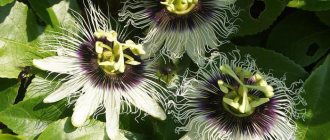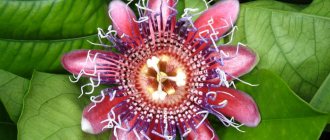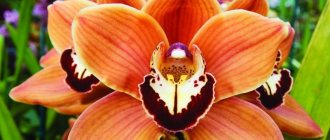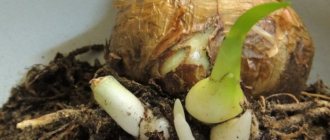The exotic fruit Passion Fruit (Passiflora) can be grown from a seed in an apartment. If it is not difficult to maintain the temperature in your home above +22 degrees, and there is a desire to carry out basic agrotechnical measures, then you can safely take on breeding a tropical species.
What are the nuances of seed preparation? What humidity and soil does Passion Fruit prefer? Growing an evergreen vine with luxurious flowers at home is an interesting activity. If an amateur gardener buys a self-pollinating variety, then it is quite possible to wait for exotic fruits to appear and surprise family and friends.
How and where does passion fruit grow in natural conditions?
Edible Passionflower is native to South America. Under natural conditions, it is a woody vine or a wide bush. Cultivated varieties are grown in open ground in the vast expanses of Central Asia and Australia. Family Passionaceae, evergreen plant.
At home, passion fruit does not grow as long as other species; the average lifespan of an exotic vine is about six years. For this reason, flowering and fruit formation begins early: already six months after germination. In the third season, the number of fruits decreases. It is useful to know about this feature of a tropical species.
External characteristics of the flower
The passion fruit houseplant has long woody shoots. The leaf plates of the flower are large, dark green, three-lobed. They are connected to flexible stems using petioles, which are 3–4 cm long.
Large star-shaped flowers appear from the axils of the leaves. Their diameter reaches 8-12 cm. Flower baskets consist of an impressively sized bract, five petals and the same number of sepals. In the central part of the flower there is a three-stigular ovary, surrounded by five stamens with large anthers. Each bud delights with its beauty for exactly one day, and then fades.
During flowering, which occurs in mid-July - early autumn, passionflower smells pleasant, but its beauty is short-lived. When the southern flower fades, edible fruit ovaries with a diameter of 6–8 cm appear. At first they are light, and as they ripen, the skin acquires a dark purple hue. The yellow pulp has a sweet and sour taste. There are bones inside, they are also eaten.
Benefits of passion fruit
The tropical fruit has a rich vitamin and mineral composition. The pulp contains almost the entire spectrum of B vitamins, ascorbic acid, tocopherol, retinol, as well as micro- and macroelements - iron, phosphorus, iodine, potassium, sodium, zinc and other substances.
Medicinal properties of passionflower fruits:
- improve intestinal function;
- help fight constipation;
- lower the temperature;
- cleanse the blood of cholesterol;
- increase immunity;
- strengthen the heart muscle;
- have an antimicrobial effect;
- remove uric acid from the body;
- tone up.
Popular varieties of passion fruit
There are several hundred species of passionflower in nature. In home floriculture, edible passionflower is grown, its other name is granadilla purple or passion fruit, as well as winged and blue. Popular indoor species and varieties:
| Name | Description | Photo |
| Galaxy | Variety with white-pink large flowers. The skin of the fruit after full ripening is brown-red | |
| Maestro | Liana up to 4.5 meters long with purple flowers, the diameter of which reaches 12 cm | |
| Granadilla reed | Its fruits are considered the most delicious. The liana is well leafed, blooms with pink-purple flowers with a diameter of 10 cm | |
| Cavalier star | Liana with white-blue flowers 6–7 cm in size, having a crown of purple threads |
The listed types of passion fruit are grown at home, but residents of the southern regions sometimes plant the overseas guest in open ground. In winter, the planting site is mulched with straw to prevent the roots from freezing. In spring, the plant produces a lot of fresh root growth.
How to choose a fruit for planting
Not all Passiflora varieties take root well at home. A beautiful vine with lush foliage and fantastic flowers can be obtained by planting Cavalier Star and Passiflora edulis (Passion Fruit). Each type has its own characteristics.
Passiflora blue
Helpful information:
- duration of flowering - from the first months of spring to September-October;
- the buds are large: from 7 to 9 cm, the smell is similar to feijoa;
- the shade of the petals is white-blue;
- each flower lives for about a day;
- orange fruits, reminiscent of a chicken egg, ripen for one and a half to two months;
- active growth, in nature the vine stretches up to 10 m;
- At home, it develops well on southern windows and produces abundant flowering. In shaded rooms the buds are small, in small quantities;
- blue passionflower tolerates cultivation well in the fresh air: in a private house you can keep a flowerpot with an exotic plant in the garden from April to October;
- Pollination is carried out by bees.
passion fruit
Edible passionflower - features:
- dark green leaves that look like blades;
- high decorativeness of the plant;
- lush evergreen vine;
- flowers are violet-white, large – up to 10 cm;
- the fruits are purple-burgundy in color, round, large (about 7 cm), the flesh is rich yellow, juicy;
- passion fruit loves the sun and grows well in homes and winter gardens;
- The heat-loving species prefers temperatures in summer from +23 to +26 degrees, in winter from +16 to +18 C;
- The temperature must not be allowed to drop below + 5 degrees: the plant dies.
For planting seeds, choose passion fruits:
- ripe;
- no damage or stains;
- without rotten parts;
- large;
- not pressed.
Important! To obtain Passion Fruit fruits at home, experienced flower growers advise buying the self-pollinating Frederik variety. In other cases, you will need two plants with male and female flowers.
What is passionflower, what does it look like: photos, signs and superstitions
The flower called “passionflower” is very unusual and rare. It is distinguished by incredibly beautiful flowering. It is not uncommon for a plant to have other, more well-known names:
- Passionflower
- Cavalier star
Passionflower has a smooth stem and can curl. The average plant length is ten meters . The leaves of the plant have an interesting color: they are green on top and gray below.
Passionflower blooms with fairly large flowers. Flowering has shades of purple, red and light white. In addition, the plant may have fruits that are no larger than an egg. Passionflower blooms throughout the summer ; the flowers die off only in the fall.
The name of the plant has a very interesting history. The word “passionflower” itself consists of two Latin words:
- "passio" - to suffer, suffering, suffering
- "flos" - bloom, flowers
Passion flower Passion fruit - passion fruit
The name of the plant was given in ancient times by missionaries traveling around the world and arriving in South America. It was to them that this flower seemed very symbolic, reminding them of the suffering of Christ.
themselves are very large, reaching ten centimeters in diameter. They are star shaped . Their color is bright and unusual, has many color shades. Flowers grow on long stalks.
The passionflower flower has five petals. That is why he is often compared to Christ, arguing that he had five wounds. In addition, the flower has exactly five sepals. Each bud and flower has an ovary , which contains three stigmas. There are also exactly five stamens around the stigmas.
Variety of passionflower flowers
Passionflower flowers have a very pleasant sweet aroma . Picking flowers will not allow them to remain fresh for a long time; they quickly wither.
There is a certain “language of flowers” that represents passionflower as a flower of respect and fidelity. That is why, if a man gives a woman passionflower, he promises her a long, strong relationship imbued with trust and sensuality.
How to plant seeds
First, the seeds are separated from the fruit, washed, dried, and part of the top layer is removed. Be sure to choose a suitable soil, taking into account the recommendations, and make a drainage layer (from 2 to 3 cm) at the bottom of the flowerpot. Plastic containers or briquettes made from natural coconut fibers are suitable for planting. Planting seeds is not difficult, you just need to strictly follow the rules given below.
At home, many amateur gardeners successfully grow various exotic fruits. It is easy to get trees and vines from the seeds: lemon, lychee, orange, mango, grapefruit, avocado, date palm. Even in the absence of fruits, the plants delight with bright greenery and a beautiful crown. After grafting, some exotic species begin to set fruit. Tropical plants look no less impressive than the usual highly decorative indoor flowers: Geranium, Hippeastrum, Dipladenia, Primula, Hyacinth, Decembrist, Uzambara violet, Azalea, Cyclamen, Amaryllis.
Seed preparation
The planting material will most likely sprout if the seeds are properly processed:
- engaged in the preparation and planting of a tropical plant immediately after extracting the seeds from the fruit;
- rinse the seeds, dry with a towel, and lightly rub each side with fine sandpaper or a nail file. It is important to remove some of the top layer to facilitate seed germination;
- then soak the prepared planting material in fresh milk at room temperature;
- You can soak passionflower seeds in a growth stimulant, which is sold in an agricultural store. Suitable preparations are Gibberelin (the base is kept for no more than three hours) and Kornevin (the seeds are soaked according to the instructions).
Preparing the pot and soil
To germinate seeds, you will need a multicomponent substrate. Ingredients: peat, chalk, deciduous soil, mineral fertilizers, clay. All ingredients for the soil mixture are taken in equal quantities. Drainage is made from clay shards, broken bricks, pebbles, or expanded clay.
The second option is to buy a coconut fiber briquette. Before germinating passionflower seeds, fill the base with warm water, allow it to swell (approximately 5 times its original volume), and check whether the excess liquid is well drained. Next, loosen the resulting base with your fingers and plant one seed in each briquette if the briquette is small.
Landing rules
Note to flower growers:
- lightly moisten the soil, dig a small hole (about 1 cm), place the seed after pre-treatment), sprinkle with soil, water moderately;
- to preserve, cover the container with passionflower seeds with a plastic bottle, the neck and a third of the container have been cut off;
- under the “hood”, in the mini-greenhouse, an optimal microclimate is created so that the passion fruit seed germinates faster;
- The greenhouse is placed in a warm room, with a temperature of about +22 degrees, with sufficient light. the sun's rays should not fall directly on the mini-greenhouse so that the humidity is always normal;
- every two or three days, open the container for a few minutes, collect drops of water on the bottle, ventilate the greenhouse, and cover the soil again;
- the timing of the appearance of sprouts varies significantly - from two weeks to a month: in most cases, the indicator depends on the ripeness of the fruit and the quality of seed treatment before planting;
- If after a couple of months there are still no shoots, you will have to dispose of the soil and unsprouted seeds and repeat the process again.
Reproduction methods
Passion fruit propagates in two ways - by seeds and cuttings. The first option is almost never used for several reasons:
- planting material quickly loses its viability;
- seedlings need twelve hours of daylight;
- If the plants take root, they will bloom only after a few years.
The cutting method is successfully used in indoor floriculture. It allows you to get several new vines within a month, and flowering will occur in the second or third year.
Seed propagation
If a gardener wants to grow passion fruit from seeds, he will have to look for fresh planting material. The hard shell of the drupes is scarified with fine sandpaper, being careful not to damage the core.
Planting material is placed in warm, settled water for 48 hours. For sowing, prepare a small container and soil made up of sand and peat. The soil is pre-moistened, the seeds are laid out on the surface, lightly pressing them with your finger. The seed box is covered with glass or transparent film.
The suitable temperature for germination is +21…+25 ºС. The container is left in a well-lit place. You will have to wait a long time for shoots. Most of the seeds may not germinate at all. The gardener should ventilate the greenhouse every day, removing the glass for 15–20 minutes, and monitor the condition of the soil, maintaining its moisture.
The dome is finally removed when the shoots appear. Seedlings dive after the appearance of two leaves using the transshipment method. Damage to delicate roots will certainly lead to the death of young plants.
Cuttings
For those gardeners who want to quickly get new specimens of passionflower, this propagation method is suitable. Cuttings are taken only from young shoots. The stems are cut into fragments 10–15 cm long. It is important that each of them has 2–4 leaves and a growing point. The lower leaf plates are removed, and the cut sites are lubricated with a root formation stimulator.
The soil mixture is made up of equal parts of sand, turf and black soil. Drainage is poured into the bottom of the container, and soil is placed on it. The cuttings are deepened into it so that a couple of leaves remain on the surface, and watered.
To ensure rapid rooting, plants are provided with high air humidity by covering the container with a transparent bag or part of a plastic bottle. Further care includes:
- daily ventilation of the greenhouse;
- soil moisture;
- protecting cuttings from direct sunlight;
- maintaining the external temperature within +21…+24 ºС.
Compliance with all conditions will speed up the rooting process. After 3–4 weeks, the cuttings will be ready to be transplanted to a permanent location.
Read! The citrus tree in your home is Calamondin.
How to care
After passion fruit seeds germinate, the greenhouse is ventilated more often and removed after a few days. It is important that the soil does not dry out, but there is no need to moisten the substrate too much. There are other nuances of growing passionflower at home: the care features are described below.
Location
The container with passion fruit seedlings is placed in a bright room, away from drafts. It is important that the room is not too hot and the sun's rays do not fall directly on the sprouts. It is convenient to place the container with passion fruit on a coffee table or a stable stand near the window.
Warning! The room with the seedlings must not be allowed to be too damp and cold. Ventilation is carried out through the window; the windows are not opened.
Temperature
Passionflower grows in natural conditions in countries where it is hot and humid. The plant should not be placed in a room with low temperature, dampness, or lack of light: fungus develops and disease resistance decreases. When putrefactive flora appears, fungicides are used.
In summer, the optimal temperature for growing Passion Fruit at home is from +23 to +26 degrees. The liana grows well even at +20°C..+21°C, but the flowering will not be as bright, and the growing season will be less active. If the home is cool, the fruits are unlikely to appear.
There is no clearly defined period of rest and passionflower, but most gardeners recommend creating suitable conditions for rest in winter. It is useful to place the evergreen vine in a cooler room (average values are from +16 to +18 degrees), reduce watering, and fertilize once a month in a minimal amount. The complex eco-fertilizer Biohumus (liquid form), diluted according to the instructions, is suitable for fertilizing the soil.
Lighting
A heat-loving plant needs a warm room with plenty of light. The evergreen passionflower vine grows well in the presence of light shade, even in shaded areas, but without the optimal level of lighting, the buds become smaller and the flowering is not as abundant.
Watering and humidity
Important points:
- The tropical plant loves a moist environment; in dry soil, all types of passionflower grow poorly, bloom poorly and rarely bear fruit.
- For watering you need well-settled liquid, slightly warm.
- Water the tropical plant abundantly, but wait until the top layer dries.
- The lower the room temperature, the less frequently the flower is watered. In winter, when the flowerpot is moved to a cool room, the frequency of watering is reduced to once every 7–8 days.
- Passionflower loves warmth, but grows well at average temperatures: about +22 degrees. In this case, the soil is not moistened as abundantly as in hot weather, otherwise rot may occur.
- The drainage layer is an essential element for proper drainage of liquid from the flowerpot. Expanded clay, pebbles, broken bricks, clay shards are suitable materials. The holes in the bottom should be of medium size. You need to check whether small elements are blocking holes for water drainage. The thickness of the drainage layer is about 2–3 cm.
Many decorative foliage indoor flowers love moisture, need regular watering, and dry out and turn yellow when there is a lack of liquid. It is useful to know about this nuance for amateur gardeners who plan to plant other evergreen trees, vines and shrubs at home: Monstera, Fern, Ficus, Screw Palm, Ledeburia, Mother-in-Law, Asparagus, Calathea, Maranta, Croton.
Transfer
The procedure is carried out as the underground and above-ground parts increase. The liana stretches out quite quickly, the roots entwine the earthen ball, and almost every year, in the first three to four years, the plant will have to be replanted.
The flowerpot should be large, approximately 5 cm larger than the previous one. If there is not enough space for roots in the pot, flowering is not as abundant and shoot growth is slow. You need to know when to stop; you shouldn’t plant a young vine right away in a large tub. The flower is replanted in mid-spring - early summer. In adult passion fruit, instead of transshipment, you can replace 3 to 5 cm of the old substrate with a new one in the flowerpot. When moving a large plant, act carefully, making sure not to destroy the earthen lump.
Reproduction
Cultivation of the tropical passionflower vine in the home is carried out using cuttings or root shoots. If you manage to get the fruits, you can grow a new vine from the obtained seeds.
The simplest and most reliable method is cuttings:
- Rooting of cut shoots with two or three leaves is carried out in a nutrient substrate, with regular watering, in a room with a moderate temperature: about +21..+22 degrees.
- You can create a greenhouse for the speedy germination of roots.
- The process is activated with the help of growth stimulants: Kornevin, Heteroauxin.
- After rooting, the young plants are transplanted into a flowerpot in a permanent place.
- In most cases, the grown vines begin to bloom as early as next year.
Fertilizers and fertilizers
At all stages of development of a tropical plant, it is useful to add organic matter and mineral components. With proper feeding, the vine quickly gains green mass and the stems actively stretch.
Vermicompost is an excellent feeding option for growing passion fruit. Biofertilizer does not burn roots and is suitable for use when growing seedlings. It is important to choose a liquid concentrate and dilute it according to the instructions. Use the product in moderation, once every 14 days.
Trimming
With good care, passionflower grows actively, and already at a height of about 10 cm you need to build a support. The branches are actively weaving, it is useful to periodically enlarge the structure so that the bush is beautiful and the shoots do not fall from the support. The branches are flexible and it is easy to shape the tropical plant into the desired shape.
Passion fruit is an evergreen vine; the plant grows quite actively, stretches out, entwines the support, and produces many side shoots. Old stems do not bloom flowers and fruits; they are periodically pruned so that the elements do not take away the juices from younger branches. Formative pruning is carried out for shoots whose length has reached half a meter. If necessary, remove broken, rotten branches from the vine.
The procedure is carried out in March. Cut shoots are suitable for cuttings.
Benefits of passion fruit
Exotic fruits contain organic acids, vitamins and minerals, they have no cholesterol, and contain healthy fiber. Passion fruit is considered an excellent antioxidant that can boost immunity, slow down the aging process and reduce the risk of developing cardiovascular diseases. The presence of fiber in fruits helps improve digestion and cleanse the intestines.
The fruit contains beta-carotene and vitamin A, which support vision, skin elasticity, and good condition of hair and nails. The sedative effect of passion fruit has a positive effect on the nervous system, relieves stress and gives sweet sleep. Passionflower has a beneficial effect on the liver and genitourinary system, helps the female body during menopause, stabilizes blood pressure, relieves migraine attacks and helps fight excess weight.
In medicine, the above-ground part of the plant is used - leaves, buds and flowers, stems, tendrils and unripe fruits. Since time immemorial, it has been used as a sedative for bone fractures and bruises, relief from pain, burns and inflammation. Passionflower relieves minor cramps and nervous conditions, has antispasmodic, antifungal and antiseptic effects, and slightly reduces the craving for alcohol and nicotine. The pharmacological industry produces tinctures, extracts, preparations and ointments.
Cocktail with passion fruit Photo: © RitaE (Pixabay Free License)
Cosmetics based on passion fruit oils and juice tone and moisturize the skin, tighten pores, help get rid of acne and protect against ultraviolet radiation, while shampoos and conditioners strengthen hair roots and prevent fragility. The benefits of this exotic fruit have been proven, and all we can do is take advantage of the recommendations of nutritionists, doctors and cosmetologists.
Properties
Passion fruit is of great value to the human body due to the presence of a lot of useful substances. The list is huge, so this is only the most important.
- The calorie content of passion fruit is about 70 kcal per 100 g of fresh fruit.
- Carbohydrate content - up to 21%, protein - 2.5%, fiber - 11%.
- Fruit juiciness is up to 40%.
- Vitamin content: A - 7.5%, B2 - 11%, B3 - 10%, B6 - 8%, B9 - 3%, C - about 36%.
- Iron content - 12%, phosphorus - 10%, copper - 9.5%, magnesium and potassium - 7% each, calcium and zinc - 1%.
Is it possible to get fruits and how to do it
Flowering of young passion fruit occurs quite quickly: many vines throw out original buds already in the first year after the first season of life. A young vine often reaches 1 m or more.
For active flowering and the appearance of juicy fruits on a Passion Fruit tree, you will need a self-pollinating variety or artificial pollination, even on dioecious plants. You need to carefully transfer pollen from male flowers to female flowers and hope for a positive result.
Don't despair if you can't grow fruit. The evergreen vine Passion Fruit, even without exotic fruits on its branches, is highly decorative. It is much easier to achieve the release of buds; the flowers of a tropical plant are unusual, large and very beautiful.
How to root passionflower with cuttings?
Rooting by cuttings:
- Passionflower propagates by cuttings. Plant shoots should be cut only from young shoots that form in the spring.
- Each detached cutting must have at least two leaves and a growing point.
- If you are cutting a shoot, the lower part of the leaves should be removed.
- For planting, you should prepare a plastic cup with holes made in the bottom and drainage placed in it.
- Soil from chernozem and turf soil is placed on top of the drainage in a one to one ratio.
- The soil should be moistened and a greenhouse should be made using glass or cling film.
- Rooting of cuttings should take place at a temperature not lower than 20 degrees.
- Glass or film is removed only after three weeks
- Strengthening the cuttings can last up to three months
Diseases and pests
Good care is the best prevention of various types of damage to indoor plants. Like many vines and decorative deciduous species, Passion Fruit at home is faced with the effects of pathogenic flora against the background of stagnant water.
Important points:
- Root rot is a consequence of excessive watering at average temperatures.
- The fungus dies after using fungicides: Skor, Trichodermin, Fundazol, Maxim, Fitosporin, Bordeaux mixture, Abiga-Pin.
- Be sure to remove the old soil, carefully wash the roots, also apply an antifungal composition to the underground part of the plant, replant it in a new container, and dispose of the old flower pot.
- It is useful to treat the window sill and window frame, stand or other surface where the flowerpot was located with fungicides.
Pests
From open windows, from contaminated soil when buying a new flower, or from other indoor plants, parasitic insects get onto the passion fruit. In most cases, owners identify the following pests: scale insects, aphids and spider mites.
What to do:
- Move infected plants to a separate room for quarantine. A simple action prevents pests from settling on other specimens in the green corner.
- Carry out disinfestation and anti-tick treatment using effective chemicals and biological agents. It is imperative to protect the body from the influence of toxic drugs: a respirator, rubber gloves, closed clothing, a hat, plastic glasses.
- To combat insects, modern insecticides are used: Fitoverm, Aktara, and in case of severe infestation of a flower - Aktellik. When spider mites infest the plant, the plant is treated with acaricides: Fufanon, Neoron, Antiklesch.
- If the number of parasites is small, it is useful to use a strong solution based on laundry soap: after applying a sticky, thick mass, the pests suffocate under the film, it is easier to remove adults and larvae.
- A soap solution is indispensable when fighting scale insects: females stick tightly to the surface of leaves and shoots, and it is impossible to separate the pests without damaging the greenery. After using a soapy solution, pests are easier to clean off with an old toothbrush.
- To prevent the infestation of ticks and harmful insects, it is useful to spray indoor flowers with garlic tincture or a decoction of tobacco leaves a couple of times a month. Supports the protective power of indoor flowers with Succinic acid for plants and the safe drug Fitosporin. Watering the soil and treating the leaves is carried out strictly according to the instructions.
Growing passion fruit (edible passionflower) at home requires the amateur gardener to pay attention to the tropical plant. Under suitable conditions, the vine blooms beautifully, and in some cases it is possible to obtain exotic fruits.
How to plant a passion fruit seed and how to care for the plant? Answers in the next video:
Why does passionflower not bloom: what to do, how to make passionflower bloom?
You can wait a very long time for passionflower to bloom. When planting seeds, you can wait up to eight years for the first flowers. However, the following methods will help you make” passionflower bloom
- Regular humidification in the morning and evening
- Sufficient amount of light , additional lighting.
- The plant should be planted in a small pot ; the plant will pay attention to putting out leaves.
- Fertilizers should not be used sparingly ; do this no more than twice a month.
IMPORTANT: The most important condition for the wild flowering of passionflower is a complete rest period for the plant in the winter.
Why does passionflower get sick?
Planting and flowering passionflower
This plant is a perennial; it is replanted once a year in the spring. When planting a small plant in the first year, it should be covered with a glass jar for 2 weeks. In the first year, passionflower forms the basis of the future vine, growing the main shoots, usually up to 1.5 m long. At the same time, it definitely needs support to gain a foothold.
In autumn, when the temperature begins to drop below +15 ˚С, the plant must be moved to a room where the temperature can be maintained at +13…+16 ˚С. If the room is hot, the vine begins to go bald and loses its leaves.
In the spring of the second year, you should prune last year's long shoots by a third of the length, taking into account that the flowers will form on fresh shoots. Passionflower blooms almost the entire summer season from June to October, but each flower lives only 1 day.
It is difficult to grow fruits indoors. To get them, you must have at least 2 plants of the same species, since they are cross-pollinated. Due to mismatched flowering on these plants, pollination may not occur. Fruits of various plant species usually ripen within 2-3.5 months.
Let's look at different varieties of edible passionflowers.
Biological description
This perennial plant can grow up to 3-4 m in length; it produces very long shoots that cling to supports with tendrils. The leaves are large, consisting of 3-5 lobes. The fruit of passionflower is a juicy multi-seeded berry; there are up to 60 edible species of passionflower, many of them are even grown as fruit plants.
The most famous and popular edible varieties of passionflower:
- Passion fruit.
- Granadilla.
- Maestro.
- Galaxy et al.
Caring for passion fruit at home
The exotic passion fruit vine is a capricious plant that needs careful attention. In addition to regular watering, you need to take care of feeding the plant. Since passionflower loves to “eat”, it is recommended to feed it frequently and generously. Start feeding in the spring, then again in the summer and again in the fall. Fertilizer should be slow-acting organic matter with a low nitrogen content. An excellent option is granulated chicken manure. In winter, fertilizers are not needed.
Important! Particular attention must be paid to quality watering.
Despite the exotic guest’s special love for humidity, you should not overdo it. It is recommended to water the vines frequently, but only after the soil surface has dried. In winter, it is enough to water once a week.
When growing passionflower at home, you need to regularly spray it with a spray bottle. Lack of moisture will lead to sad consequences in the form of dropped leaves and buds.
The nuances of growing at home
Passion fruit is a fairly heat-loving fruit. It grows quickly and begins to cling to any support points. Therefore, you should worry about organizing the suspension system in advance. The best option is a mesh.
During growth, the vine and leaves of the plant grow rapidly, so initially you need to organize a strong foundation. There is no need to worry about additional garters, since the passion fruit tendrils themselves are reliable and cling tightly.
The plant is unpretentious in choosing soil, so it can even be planted in turf brought from a nearby forest.
For full growth, bright lighting is required. There is no need to worry about shading again.
Important! Passion fruit grows well in the shade. However, in this case you should not count on active flowering.
The room should be regularly ventilated; this is very beneficial for the plant. In summer, she especially needs fresh air, so it is recommended to place the pot with the seedling near an open window or take it out onto the balcony.
Using passion fruit for food
In our country, the fruits of edible passionflower (passion fruit and other types) can only be found in additives to yoghurt, ice cream or juice. Very rarely, a piece of the fruit can be found in tropical tea blends.
The pulp of this fruit is very tasty and sweet; in its homeland it is consumed raw, mixed with sugar and water, and for making jams, jellies and sorbets. Often pieces of this fruit are added to curd desserts and cakes.
Sweet juice and jam can be used in preparing meat and fish dishes; the fruit tastes best with nuts, apples, cinnamon and pear.
However, caution should be exercised, because some varieties (for example, Azure passionflower) contain a small percentage of cyanide, while some others contain weaker toxic substances harmful to human health.
Contraindications to the use of passion fruit
This fruit should be consumed with extreme caution by those who have experience in dealing with any allergic manifestations. It is extremely rare, but individual intolerance to exotic fruits still occurs. Passion fruit should not be used to feed young children. Even if a child is not prone to allergies, the baby’s immature gastrointestinal tract can react in the most extraordinary way.
People suffering from diabetes should be aware that when passion fruit is stored in a cool place for a long time, the amount of sugar in them increases significantly. Particular attention should be paid to thorough cleaning of fruits purchased in the retail chain, since to preserve the fruits during long-term transportation they are treated with wax and antibacterial agents. It is advisable that these drugs do not enter the body during food.
The use of passion fruit will bring many benefits to consumers of exotic fruits. Its rich composition normalizes many body functions, has a positive effect on the condition of the skin, nails, and hair, and growing this plant at home will bring many pleasant experiences.
Author of the article:
Kuzmina Vera Valerievna |
Endocrinologist, nutritionist Education: Diploma of the Russian State Medical University named after. N.I. Pirogov, specialty “General Medicine” (2004). Residency at the Moscow State Medical and Dental University, diploma in Endocrinology (2006). Our authors











